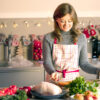The holidays are a time to share. We share food, stories, and mainly, quality time. But sometimes, doing so also means we spread germs. If you want to boost your immune system this holiday season, you can do more than wash your hands any time your little nieces and nephews grab it to show you their latest creation. Consider these three exercises, perfecting for boosting your immune system.
A 2019 review in the Journal of Sport and Health Science found that moderate exercise can boost your immune system’s defense activity and metabolic health. Science Daily reported on a recent analysis that was published in the journal Exercise Immunology Review. By keeping your immune system healthy, you increase your chances of warding off viruses — COVID-19 and others — and exercise remains one of the most effective (and science-backed) ways to do so. Plus, you’ll feel better and have more energy!
The Department of Health and Human Services suggests a minimum of 150 minutes of moderate exercise or 75 minutes of vigorous exercise per week. They don’t specify types of activity, so we list three forms of exercise and outline the additional benefits of doing them for you to try.
Give them a try: you’ll be stronger — in more ways than one — for it.
3 Types of Exercise to Boost Your Immune System
Strength Training
strength training is a method of exercise that includes moves meant to improve your body’s strength and stamina. Plus, it might just help boost your immune system. Here’s a quick primer on how muscles get bigger and stronger.
If you’ve never performed, say, a pushup before and then do one rep, you’re introducing a new stressor to your working muscles — in this case, your chest, arms, and shoulders. As a result, the muscle tissues experience micro-tears, and the will body repairs them, to adapt, and they become both bigger and stronger as a result. That said, you don’t need lots of weight to elicit a change. If you’re new to strength training even the easiest variations of exercises will stimulate a response, and as you get stronger, you can increase the weight, reps, sets, or reduce your rest time to keep progressing.
As for what the science says, strength training has been proven to increase muscle mass in adults (which translates to more calories burned at rest) and less fat mass. Beyond a better body, studies also link strength training to improved coordination, better cognitive function, higher bone density, and reduced back pain in inactive adults. Ipso facto: you’ll look and feel better.
Try this routine:
Walking and Hiking
Not ready to try strength training? Take a walk. Being inside and glued to our screens is not good for us — we don’t need research to tell us that, although it does. Though social distancing regulations are in place, you can go outside, which is what you should be doing because it lowers depression. A 2015 study from Stanford University linked 90-minute bouts of walking outdoors to decreased activity in the part of the brain that’s associated with depression. The more difficult terrain of trail hiking increases your workout intensity and you get to see more of nature.
High-Intensity Interval Training
Also known as HIIT, high-intensity interval training has you perform an exercise hard as you can, for a set time (usually anywhere from 20 to 60 seconds) and then resting for the same amount of time. Compared to slow-and-steady exercise, you’ll jack your heart rate up far higher, far faster. It’s very strenuous, but the bonus is that a HIIT session typically lasts for about 15-20 minutes.
If it’s been a while since you exercised regularly, skip HIIT to start and build up your base level of fitness with light strength training and walking. It is intense. It’s that intensity, though, that garners an “afterburn” effect, where your body continues to use calories for hours after your workout, about 6 to 15% of your total calories burned from the initial session. Another study shows that a 30-second all-out sprint on a bike produced a 450% increase in human growth hormone production, which repairs brain and muscle tissues, boosts metabolism, and aids in fat loss.
Try this HIIT Workout:
Looking for more tips? Check out MedShadow’s 8 Superfoods to Boost Your Immune System.






